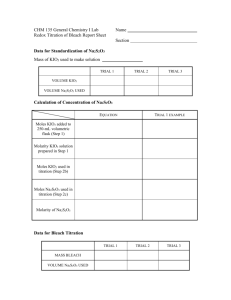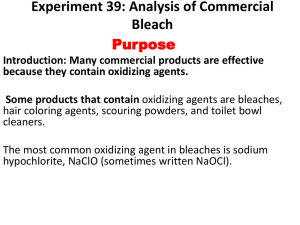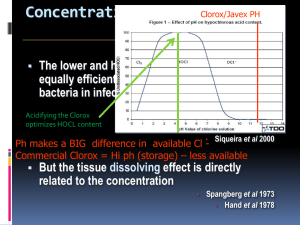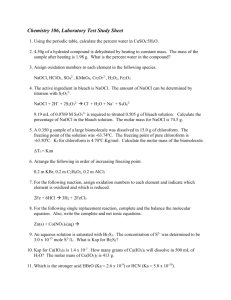Oxidizing Power
advertisement
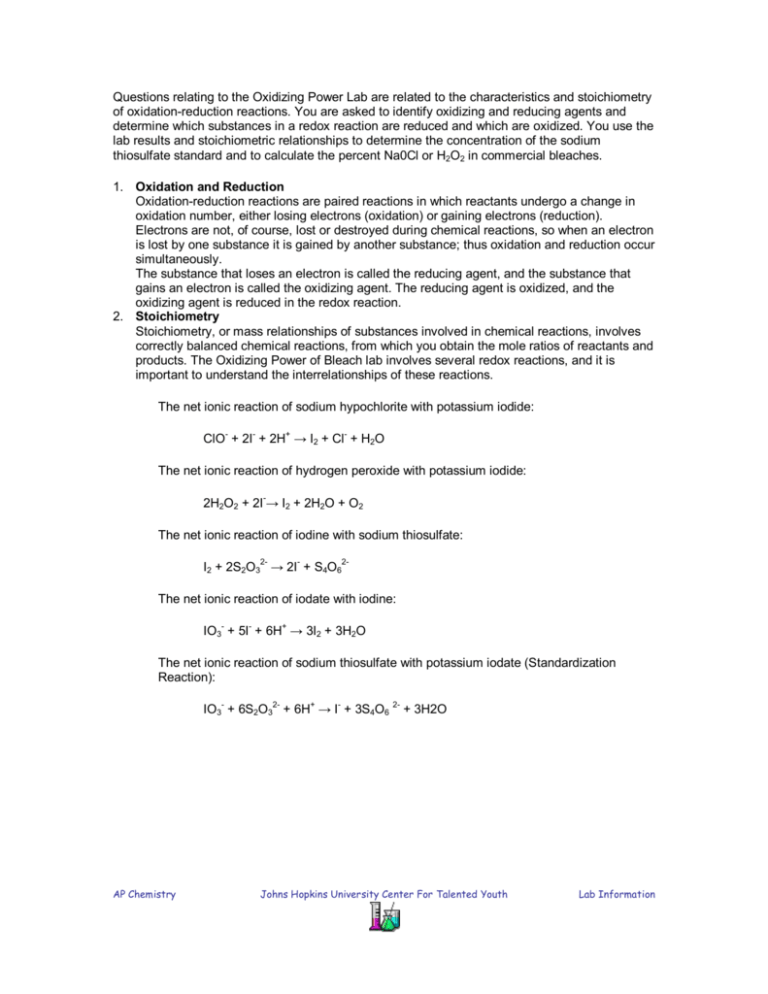
Questions relating to the Oxidizing Power Lab are related to the characteristics and stoichiometry of oxidation­reduction reactions. You are asked to identify oxidizing and reducing agents and determine which substances in a redox reaction are reduced and which are oxidized. You use the lab results and stoichiometric relationships to determine the concentration of the sodium thiosulfate standard and to calculate the percent Na0Cl or H2O2 in commercial bleaches. 1. Oxidation and Reduction Oxidation­reduction reactions are paired reactions in which reactants undergo a change in oxidation number, either losing electrons (oxidation) or gaining electrons (reduction). Electrons are not, of course, lost or destroyed during chemical reactions, so when an electron is lost by one substance it is gained by another substance; thus oxidation and reduction occur simultaneously. The substance that loses an electron is called the reducing agent, and the substance that gains an electron is called the oxidizing agent. The reducing agent is oxidized, and the oxidizing agent is reduced in the redox reaction. 2. Stoichiometry Stoichiometry, or mass relationships of substances involved in chemical reactions, involves correctly balanced chemical reactions, from which you obtain the mole ratios of reactants and products. The Oxidizing Power of Bleach lab involves several redox reactions, and it is important to understand the interrelationships of these reactions. The net ionic reaction of sodium hypochlorite with potassium iodide: ClO ­ + 2I ­ + 2H + → I2 + Cl ­ + H2O The net ionic reaction of hydrogen peroxide with potassium iodide: ­ 2H2O2 + 2I → I2 + 2H2O + O2 The net ionic reaction of iodine with sodium thiosulfate: I2 + 2S2O3 2­ → 2I ­ + S4O6 2­ The net ionic reaction of iodate with iodine: ­ ­ + IO3 + 5I + 6H → 3I2 + 3H2O The net ionic reaction of sodium thiosulfate with potassium iodate (Standardization Reaction): IO3 ­ + 6S2O3 2­ + 6H + → I ­ + 3S4O6 2­ + 3H2O AP Chemistry Johns Hopkins University Center For Talented Youth Lab Information 3. Sample Calculations Standardization of Sodium Thiosulfate Determine the concentration of Na2S2O3 solution if 23.55 mL are required to titrate the iodine formed from the reaction of a 20.00 mL of a 0.0100 M solution of KClO with excess KI.3 o First, determine the number of moles that react: moles KClO3 = (0.02000 L)(0.010 mol KCL03/L) = 2.00 x 10 ­4 mol KClO3 o Then use the mole ratio of NaOCl to sodium thiosulfate to KClO to determine the number of moles of Na2S2O3 that react: (2.00 x 10 ­4 mol KIO3) x (6 mol Na2S 2O3 / 1 mol KIO3) = 1.20 x 10 ­3 moles Na2S2O3 o Finally, use the volume of Na2S23 titrated to determine the molarity: 1.20 x 10 ­3 mol / 0.02335 L = 0.0520 M Na2S2 O3 Percent Sodium Hypochlorite in Bleach A 0.415 g sample of bleach is treated with an excess of KI and, after the reaction is completed, 8.73 mL of a 0.0.0736 M solution of Na2S2O3 is required to titrate the iodine liberated in the reaction. Determine the percent NaOCl in the bleach sample. o First, determine the number of moles of Na2S2 O3 that react: ­3 moles Na2S2O3 = (0.00873 L) x (0.0736 mol Na2S2O3/L) = 6.43 x 10 moles Na2S2O3 o Then, use the mole ratio of NaOCl to Na2S2 O3 to determine the number of moles NaOCl in the sample: (6.43 x 10 ­3 mol Na2S2O3) x (1 mol NaOCl / 2 mol Na2S2O3) = 3.21 x 10 ­3 moles NaOCl o Next, convert the moles NaOCL to grams NaOCl: (3.21 x 10 ­3 mol NaOCl) x (74.5 g NaOCl/mol NaOCL) = 0.0239 g NaOCl o Finally, calculate the percent NaOCl in the sample: 0.0239 g NaOCl / 0.415 g bleach x 100 = 5.76% NaOCl AP Chemistry Johns Hopkins University Center For Talented Youth Lab Information
